Electron-donable heterojunctions with synergetic Ru-Cu pair sites for biocatalytic microenvironment modulations in inflammatory mandible defects
- PMID: 39505847
- PMCID: PMC11541594
- DOI: 10.1038/s41467-024-53824-y
Electron-donable heterojunctions with synergetic Ru-Cu pair sites for biocatalytic microenvironment modulations in inflammatory mandible defects
Abstract
The clinical treatments of maxillofacial bone defects pose significant challenges due to complex microenvironments, including severe inflammation, high levels of reactive oxygen species (ROS), and potential bacterial infection. Herein, we propose the de novo design of an efficient, versatile, and precise electron-donable heterojunction with synergetic Ru-Cu pair sites (Ru-Cu/EDHJ) for superior biocatalytic regeneration of inflammatory mandible defects and pH-controlled antibacterial therapies. Our studies demonstrate that the unique structure of Ru-Cu/EDHJ enhances the electron density of Ru atoms and optimizes the binding strength of oxygen species, thus improving enzyme-like catalytic performance. Strikingly, this biocompatible Ru-Cu/EDHJ can efficiently switch between ROS scavenging in neutral media and ROS generation in acidic media, thus simultaneously exhibiting superior repair functions and bioadaptive antibacterial properties in treating mandible defects in male mice. We believe synthesizing such biocatalytic heterojunctions with exceptional enzyme-like capabilities will offer a promising pathway for engineering ROS biocatalytic materials to treat trauma, tumors, or infection-caused maxillofacial bone defects.
© 2024. The Author(s).
Conflict of interest statement
The authors declare no competing interests.
Figures

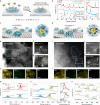

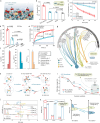
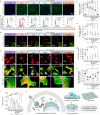
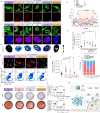

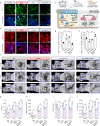
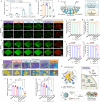
Similar articles
-
Constructing Electron-Rich Ru Clusters on Non-Stoichiometric Copper Hydroxide for Superior Biocatalytic ROS Scavenging to Treat Inflammatory Spinal Cord Injury.Adv Mater. 2024 Nov;36(48):e2411618. doi: 10.1002/adma.202411618. Epub 2024 Oct 12. Adv Mater. 2024. PMID: 39394880
-
Infectious and Inflammatory Microenvironment Self-Adaptive Artificial Peroxisomes with Synergetic Co-Ru Pair Centers for Programmed Diabetic Ulcer Therapy.Adv Mater. 2024 Sep;36(38):e2408787. doi: 10.1002/adma.202408787. Epub 2024 Aug 3. Adv Mater. 2024. PMID: 39096078
-
Bioinspired artificial antioxidases for efficient redox homeostasis and maxillofacial bone regeneration.Nat Commun. 2025 Jan 20;16(1):856. doi: 10.1038/s41467-025-56179-0. Nat Commun. 2025. PMID: 39833195 Free PMC article.
-
Engineering H2O2 Self-Supplying Platform for Xdynamic Therapies via Ru-Cu Peroxide Nanocarrier: Tumor Microenvironment-Mediated Synergistic Therapy.ACS Appl Mater Interfaces. 2024 May 15;16(19):24172-24190. doi: 10.1021/acsami.3c18888. Epub 2024 Apr 30. ACS Appl Mater Interfaces. 2024. PMID: 38688027 Free PMC article.
-
Biocatalytic Nanomaterials: A New Pathway for Bacterial Disinfection.Adv Mater. 2021 Aug;33(33):e2100637. doi: 10.1002/adma.202100637. Epub 2021 Jul 3. Adv Mater. 2021. PMID: 34216401 Free PMC article. Review.
Cited by
-
MnGA with multiple enzyme-like properties for acute wound healing by reducing oxidative stress and modulating signaling pathways.Mater Today Bio. 2024 Dec 27;30:101435. doi: 10.1016/j.mtbio.2024.101435. eCollection 2025 Feb. Mater Today Bio. 2024. PMID: 39850242 Free PMC article.
-
Bioinspired ruthenium-manganese-oxygen complex for biocatalytic and radiosensitization therapies to eradicate primary and metastatic tumors.Nat Commun. 2025 Aug 16;16(1):7640. doi: 10.1038/s41467-025-62999-x. Nat Commun. 2025. PMID: 40819134 Free PMC article.
References
-
- Kang, H. W. et al. A 3D bioprinting system to produce human-scale tissue constructs with structural integrity. Nat. Biotechnol.34, 312–319 (2016). - PubMed
-
- Murphy, S. V., De Coppi, P. & Atala, A. Opportunities and challenges of translational 3D bioprinting. Nat. Biomed. Eng.4, 370–380 (2019). - PubMed
Publication types
MeSH terms
Substances
Associated data
Grants and funding
- 52161145402, 52173133, 52373148/National Natural Science Foundation of China (National Science Foundation of China)
- 82470962, 82001020/National Natural Science Foundation of China (National Science Foundation of China)
- U21A20368/National Natural Science Foundation of China (National Science Foundation of China)
- sklpme2021-4-02/State Key Laboratory of Polymer Materials Engineering
LinkOut - more resources
Full Text Sources
Medical

